Millions of tons of trash dumped into world’s oceans
Millions of tons of plastic trash flow into the world’s oceans each year, and a new study finds that most of it comes from China and developing economies in Asia.
The study, published in Friday’s edition of the journal Science, estimates that China’s heavily coastal population contributes 1.3 million to 3.5 million metric tons of plastic to the world’s oceans each year, largely due to mismanaged waste.
Eight of the top 10 contributors were in Asia, including Indonesia, the Philippines, Vietnam, Sri Lanka, Thailand, Malaysia and Bangladesh, according to the study, which estimated that 4.8 million to 12.7 million metric tons of plastic wound up in the world’s oceans in 2010.
“Our low-end estimate is equivalent to the amount of tuna fished from the ocean in a single year,” said oceanographer Kara Lavender Law of the Sea Education Assn. in Woods Hole, Mass., the study’s senior author. “We are taking out tuna and putting in plastic.”
Assuming the true figure is in the middle of the range — about 8 million metric tons — the amount of debris “is the same as five [trash] bags filled with plastic for every foot of coastline in the world,” added coauthor Jenna Jambeck, a University of Georgia environmental engineer.
Although flotillas of plastic trash have been reported in Earth’s oceans since the 1970s, there has been little attempt to quantify its origin, largely because data are incomplete or difficult to obtain.
However, the ecological effects of the long-lasting trash, much of it matted up in massive ocean gyres, are becoming more clear.
Fish and other sea animals can ingest large pieces of plastic that clog their intestines, or can become entangled in plastic and suffocate, studies show. As the plastic breaks down to smaller pieces, it can be ingested by smaller invertebrates that are the base of the food chain.
A study last year found the amount of floating plastic in the oceans had not increased since the 1980s, despite increased plastic production. Researchers involved in that work suspect the plastic is still there, but has been breaking down into small pieces that sink deep into the water column, where marine life can mistake it for zooplankton, and consume it.
For the new study, researchers focused on plastic discarded from coastal population areas. They had to rely on indirect methods to quantify how much plastic was in waste that was not properly disposed of, and then estimate how much was likely to end up in oceans.
Researchers used 2005 data from the World Bank to come up with figures on the amount of waste generated per capita as well as the amount of that waste that was plastic. The data were available for only for 73 countries; for the other countries, the researchers made conservative estimates based on the figures for other countries with similar per-capita incomes.
The researchers then assumed that the amount of plastic waste grew by 0.19% per year since 2005. That figure was derived in part from the growth in U.S. plastic waste since the 1960s, as measured by the Environmental Protection Agency.
Nearly one-third of the 100 million metric tons of plastic waste generated by the world’s coastal population is mismanaged. Quantifying the precise amount that ultimately washes out to sea is problematic, though, since there is a dearth of reliable data.
A 2012 San Francisco Bay Area study found that street sweeping, storm water catchment and pumping stations in 71 municipalities missed about 61% of trash. The researchers used more conservative estimates in their models, ranging between 15% and 40%.
Few of the top contributing countries have adequate infrastructure for handling trash disposal, the study authors noted. Even with a well-developed infrastructure to handle solid waste, the U.S. contributed 40,000 to 110,000 metric tons per year, and ranked 20th, they found.
If waste practices don’t change and economies and populations continue on their present trajectories, the mass of plastic likely to flow into the oceans each year will just about double by 2025, the researchers projected.
But even small changes could stem the growth, the authors suggested. If the top 20 countries cut mismanaged waste in half, the total mass of mismanaged plastic would drop 41%, the study estimated.
“The solutions needs to be a combination of global and localized efforts,” said Jambeck, who added that she uses a refillable water bottle and reusable grocery bags.
For science news that isn’t garbage, follow me on Twitter @LATsciguy and “like” Los Angeles Times Science & Health on Facebook.







